#Mannerist paintings in Siena
Explore tagged Tumblr posts
Text

Saint_Lucy_by_Domenico_di_Pace_Beccafumi.jpg
#wikimedia commons#1520s#1521#Saint Lucy by Domenico Beccafumi#Paintings in the Pinacoteca Nazionale (Siena)#Paintings of Saint Lucy in Italy#16th-century paintings of Saint Lucy#1520s paintings from Italy#1520s paintings of people#1521 paintings in Italy#16th-century oil on panel paintings in Italy#16th-century oil paintings of standing women at three-quarter length#16th-century paintings of Christian saints#Mannerist paintings in Siena#Paintings of adolescent girls#Paintings of Christian saints holding attributes#Paintings of Christian saints holding swords#Paintings of women with swords#16th-century women looking at viewer in art#1520s religious paintings in Italy#Saint Lucy's eyes#Images from Web Gallery of Art#Paintings without Wikidata item#PD-old missing SDC copyright status#CC-PD-Mark#PD-Art (PD-old-100)#PD-Art missing SDC copyright status#WGA files missing P6243 property#WGA form: painting#WGA type: religious
2 notes
·
View notes
Text
Ladies please share to spread the word about two exhibits featuring women artists in two different cities
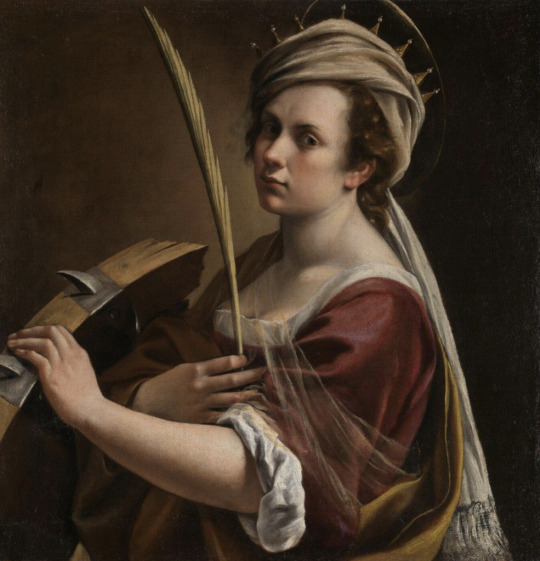
Artemisia Gentileschi, Self Portrait as Saint Catherine of Alexandria (ca. 1615–17). Collection of the National Gallery, London.
Renaissance art calls to mind some of the greatest names in art history—Da Vinci, Raphael, Michelangelo, and Donatello, just to name a few. Lesser known, however, are the influential women artists who shaped the era.
Referring to a period that bridged the end of the Middle Ages and early Modernism, the Renaissance was marked by a widespread effort to recover and advance the accomplishments of classical antiquity. Originating in Florence, Italy, but soon spreading throughout Europe, Renaissance art saw the advent of advanced linear perspective and an increase in realism. Many women artists—famous in their own time—were among these great visionaries.
Though for centuries, these women artists were largely overlooked in the annals of art history, contemporary scholarship has begun a long overdue reappraisal and rediscovery of their lives and works. Evidence of this resurgence of interest in the women artists of the Renaissance can be seen in the two current major museum shows in the U.S. that are dedicated to just that. “Strong Women in Renaissance Italy” at the Museum of Fine Arts, Boston brings together over 100 works from the 14th through early 17th century, exploring the lives and work of Italian women artists and is on view through January 7, 2024. At the Baltimore Museum of Art, “Making Her Mark: A History of Women Artists in Europe, 1400–1800” is a sweeping exhibition that aims to rectify critical oversight and bring awareness to historical women artists, and is also on view through January 7, 2024,.
In light of these two important exhibitions, we’ve brought together a brief introduction to five Renaissance women artists whom we think you should know.
Plautilla Nelli (1524–1588)
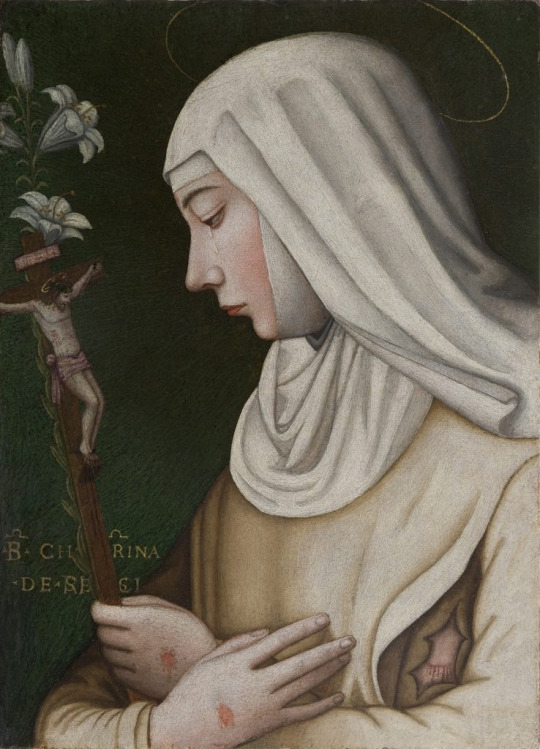
Plautilla Nelli, St. Catherine with Lily (ca. 1550). Collection of Le Gallerie Degli Uffizi, Florence.
Plautilla Nelli was a nun of the Dominican order at the convent of St. Catherine of Siena in Florence—and is considered by many scholars to be the first-known woman artist of Renaissance Italy. A self-taught painter, Nelli led a women’s artist workshop from the convent, and she was one of the few women mentioned in Vasari’s seminal treatise Lives of the Most Excellent Painters, Sculptors, and Architects. Because she developed her practice without formal training and was forbidden from studying male nudes, Nelli frequently copied works by other artists, as well as motifs from religious texts and sculpture.

Nelli’s work recently came into the limelight for her immense painting Last Supper, dating to 1568. Measuring over 21 feet long and 6 feet high, the painting remained in her convent’s refectory until the early 19th century, before being moved to another convent’s refectory and, ultimately, being placed in storage. Following an early 20th-century restoration and several more moves, it went on view to the public for the first time in over four centuries at the Santa Maria Novella Museum in 2019. Hanging alongside other masterworks by artists like Brunelleschi, it finally is getting the widespread recognition it deserves.
Catharina van Hemessen (1528–after 1565)
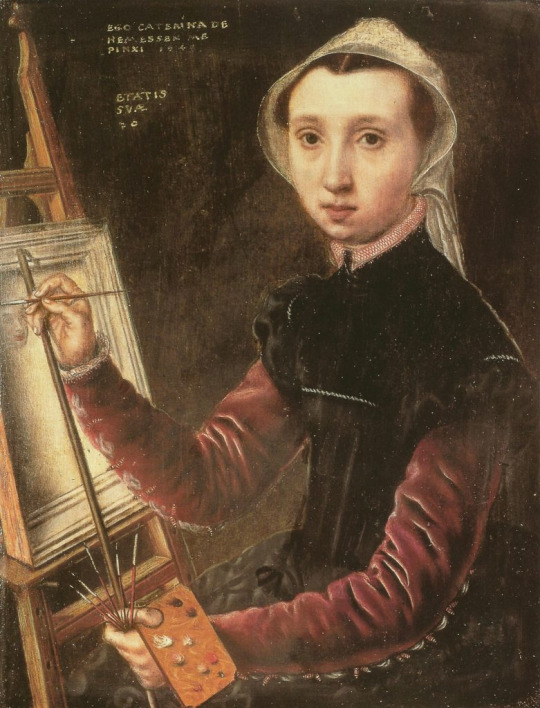
Catharina van Hemessen, Self-Portrait (1548). Collection of Kunstmuseum Basel.
Northern Renaissance painter Catharina van Hemessen was the daughter of prominent Mannerist painter Jan Sanders van Hemessen, and is the earliest Flemish woman painter with verified work that still exists today. Hailing from Antwerp, van Hemessen achieved success in her lifetime, including obtaining the patronage of Maria of Austria, regent of the Low Countries. She was included both in Vasari’s collection of artist biographies, as well as artist biographer Lodovico Guicciardini’s Description of the Low Countries (1567). Van Hemessen’s greatest claim to fame, however, is that she is attributed with completing the first known self-portrait of an artist at their easel—a compositional approach that has become a pillar of the art historical canon, as it has been taken up by artists ranging from Rembrandt van Rijn to Norman Rockwell.

Though she created religious images, she was most well known as a portraitist. Eight portraits and two religious compositions signed by van Hemessen have survived, dating between 1548 and 1552. Notably, there are no verifiable works dating to later than 1554, which have led scholars to believe she ceased painting following her marriage to organist Christian de Morien that year—though there are records she continued to teach three male apprentices.
Sofonisba Anguissola (ca. 1532–1625)

Sofonisba Anguissola, Self-portrait (ca. 1535–1625). Collection of Łańcut Castle Museum, Poland.
Sofonisba Anguissola was one of the most successful women artists of the Renaissance, with a reputation that rose to international acclaim in her lifetime. Born into a noble Milanese family, Anguissola was able to pursue her artistic aspirations with the support of her family, and began her formal training as a teenager; first apprenticing with Bernardino Campi for three years before working with Bernardino Gatti. Her position also allowed for her to become acquainted with Michelangelo, whom she exchanged drawings with. Her early career saw her complete numerous self-portraits as well as portraits of her sisters, including The Game of Chess (1555), which are noted for their realism and liveliness.

Sofonisba Anguissola, The Game of Chess (ca. 1555). Collection of the National Museum in Poznań, Poland.
Anguissola’s reputation as a painter quickly spread, and she was invited to join the court of King Philip II of Spain in Madrid in approximately 1559. Throughout her 14-year tenure there, she completed many official portraits of both members of the royal family and members of the court, adopting the formal and intricate style expected—though unfortunately, no work from this period survived due to a palace fire in the 18th century. Having garnered considerable royal favor, she ultimately spent the remainder of her life continuing to paint as well as teach and engage with young, up-and-coming artists. In 1624, one such young artist by the name of Anthony van Dyck visited Anguissola and recorded his visit in a series of sketches and noted that he learned more about the principles of painting from her than from anything else he had encountered.
Lavinia Fontana (1552–1614)

Lavinia Fontana, Self-portrait at the Spinet with Maid (1577). Collection of the Accademia Nazionale di San Luca, Rome.
Trained by her artist father Prospero Fontana, a teacher at the School of Bologna, Lavinia Fontana is considered the first professional woman artist insofar as she supported herself and her family solely on the income from her commissions. Unconventional for the time, her husband acted as her agent and took a primary role in childcare for their 11 children. She began her commercial practice in her mid-twenties, creating small devotional paintings, but later began and excelled at creating portraits—and became a favorite of Bolognese noblewomen who vied for her services. Unusual for the period, she also created large-scale mythological or religious paintings that occasionally featured female nudes.
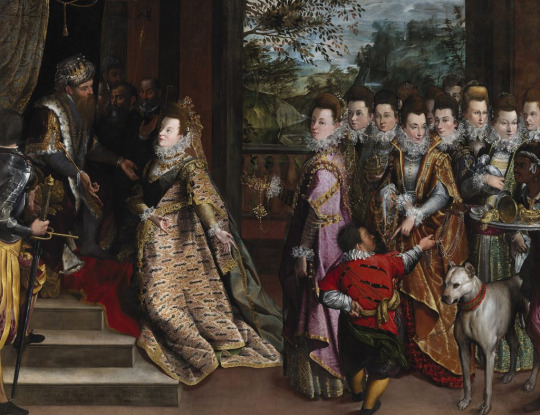
Lavinia Fontana, The Visit of the Queen of Sheba to King Solomon (1599). Collection of the National Gallery of Ireland, Dublin.
In the early years of the 17th century, she was invited to Rome at the invitation of Pope Clement VIII and was soon appointed as an official portraitist at the Vatican, counting Pope Paul V as one of her sitters. Her career success continued to thrive, as evidenced by the numerous honors she received, and the bronze portrait medallion cast in her likeness by sculptor and architect Felice Antonio Casoni. She was also one of the first women elected to the Accademia di San Luca in Rome.
Artemisia Gentileschi (1593–1653)
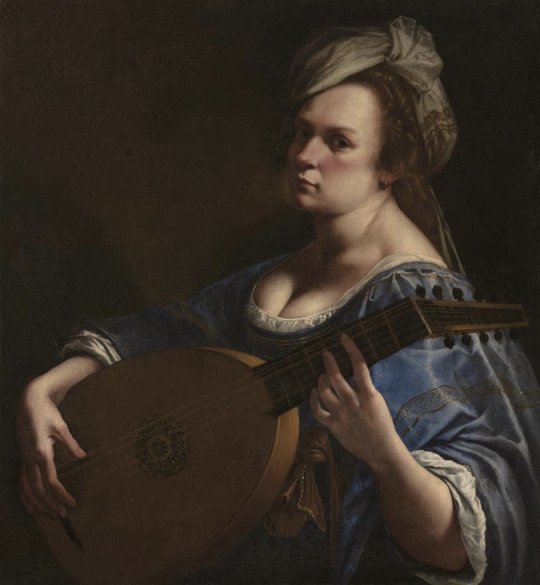
Artemisia Gentileschi, Self-portrait as a Lute Player (ca. 1615–1618). Collection of the Wadsworth Atheneum Museum of Art, Hartford.
Unlike many of her predecessors, Artemisia Gentileschi has maintained a level of renown over the centuries, with her dramatic and dynamic oeuvre that was unprecedented in her own time. Her Baroque compositions helped usher in a new era of painting. Today, her paintings draw the attention of global audiences. Born in Rome, her father was the painter Orazio Gentileschi, who trained Artemisia starting at an early age. Inspired greatly by the work of Caravaggio and his use of high-contrast compositions, her paintings garnered and maintained attention for their naturalism and nuance, as they broke from the idealism of generations past.

Artemisia Gentileschi, Judith and Her Maidservant with the Head of Holofernes (ca. 1623–1625). Collection of the Detroit Institute of Arts.
In 1612, Gentileschi relocated to Florence, which is where she first achieved major career success, including securing patronage from the House of Medici and being the first woman to attend the Accademia delle Arti del Disegno. From her oeuvre, Gentileschi has become most well-known for her self-portraits as well as religious scenes, specifically the story of Judith Beheading Holofernes—of which there are at least six known variations she completed. Gentileschi’s tendency to portray women as the protagonists of her works—and as equals to their male counterparts—made her innovative in her time and has subsequently secured her legacy as one of the most influential artists within Western art history—of either sex.
#Women in Art#Strong Women in Renaissance Italy#Museum of Fine Arts#Boston#There until January 7 2024#Making Her Mark: A History of Women Artists in Europe 1400 -1800#Baltimore Museum of Art#Plautilla Nelli (1524–1588)#Catharina van Hemessen (1528–after 1565)#Catharina van Hemessen created a whole genre in self portraits#Sofonisba Anguissola (ca. 1532–1625)#Lavinia Fontana (1552–1614)#Artemisia Gentileschi (1593–1653)
12 notes
·
View notes
Text

"And you, wandering spirits,
to whom heaven gave such great gifts
as to win you the bliss
of eternal citizenship above.
Let my humble prayer be heard in heaven:
though I am far away, living in horrible darkness
and buried alive on the Arno,
Make my name, that best part of me
that stays here on the Tiber, purged of all dross,
remain alive among your precious treasures."
Laura Ammanati (born Battiferri) was a celebrated poet and literary scholar in the cultural circles of Renaissance Florence, which included her husband, the prominent architect and sculptor Bartolomeo Ammanati, and Agnolo Bronzino, the erudite Mannerist artist who painted Battiferri’s portrait and exchanged sonnets with her. She was an honored member of literary societies such as the Accademia degli Intronati of Siena and the Accademia degli Assorditi in her native town of Urbino. Her principal collection of poems, Il primo libro delle opere toscane (The First Book of Works in Tuscan), was published in 1560.
In her younger years, Laura aggressively sought recognition for her art, and actively forwarded her career but in her later life she withdrew from the public eye. She spent most of her days meditating, praying, or composing unprinted spiritual poetry in the private chapel that Bartolomeo had built for her at their villa in Camerata. While in the process of compiling the third and final anthology of poetry, her Rime, Laura died in 1589. Her husband attempted to have it completed, but Bartolomeo also died before the process was completed. Laura and Bartolomeo were both buried at the Church of San Giovannino At least one-third of her entire written works were never published. Her late productions—hundreds of spiritual sonnets, biblical narrative poems, and her incomplete epic on the Hebrew kings—was entrusted to the Biblioteca Casanatense in Rome and nearly none of it ever came to light.
#perioddramaedit#history#edit#history edit#laura Ammanati#poet#rinascimento#italian renaissance#women of renaissance#renaissance italy#renaissance women#donne nella storia#donne della storia#donneitaliane#donne italiane#renaissance#laura Battiferri#firenze#italiansedit#bartolomeo Ammanati#agnolo bronzino#Il primo libro delle opere toscane#tuscany#women of history#historical women#women writers#women in history#historical figures#historyedit#aesthetic
25 notes
·
View notes
Photo




Sister Plautilla Nelli (1524–1588) was a self-taught nun-artist and the first known female Renaissance painter of Florence. She was a nun of the Dominican convent of St. Catherine of Siena located in Piazza San Marco, Florence, and was heavily influenced by the teachings of Savonarola and by the artwork of Fra Bartolomeo.
Life
Pulisena Margherita Nelli was born into a wealthy family in the San Felice area of Florence. Her father, Piero di Luca Nelli, was a successful fabric merchant and her ancestors originated from the Tuscan valley area of Mugello , as did the Medici dynasty . There is a modern-day street in Florence, Via del Canto de' Nelli, in the San Lorenzo district, named for her family, and the New Sacristy of the Church of San Lorenzo is the original site of her family homes.
She became a nun at the age of fourteen, taking on the name Suor Plautilla, at the convent of Santa Caterina di Cafaggio; she would later be prioress on three occasions. The facility was managed by the Dominican friars of San Marco, led by Savonarola. About half of all educated girls in that era were placed into convents to avoid the cost of raising a dowry. Savonarola's preachings promoted devotional painting and drawing by religious women to avoid sloth, thus the convent became a center for nun-artists. Her sister, also a nun, Costanza, (Suor Petronilla) wrote a life of Savonarola.
Nelli had the favor of many patrons (including women), executing large pieces and miniatures. Sixteenth-century art historian Giorgio Vasari wrote, "and in the houses of gentlemen throughout Florence, there are so many pictures, that it would be tedious to attempt to speak of them all." Fra' Serafino Razzi, a sixteenth-century Dominican Friar, historian and Savonaroliano (disciple of Savonarola), named three nuns of Santa Caterina as disciples of Plautilla, Suor Prudenza Cambi, Suor Agata Trabalesi, Suor Maria Ruggieri, and three others as additional producers: Suor Veronica, Suor Dionisia Niccolini, and his sister Suor Maria Angelica Razzi.
Art and style
Though she was self-taught, she copied works of the mannerist painter Agnolo Bronzino and high Renaissance painter Andrea del Sarto . Her primary source of inspiration came from copying works of Fra Bartolomeo , which mirrored the classicism -style enforced by Savonarola's artistic theories. Fra Bartolomeo left his drawings to his pupil, Fra Paolino who, in turn left them in the possession of "a nun who paints" in the convent of Santa Caterina da Siena. Nelli signed her paintings as "Pray for the Paintress" after her name, confirming her role in spite of her gender. Her work is distinguished from that of her influencers by the heightened sentiment she added to each of her characters' expressions. Author Jane Fortune referred to her Lamentation with Saints and the "raw emotional grief surrounding Christ's death as depicted through the red eyes and visible tears of its female figures" as a case in point. Nelli's Lamentation, which is now in the Museum of San Marco, Florence, has also spurred the writings of The Painter-Prioress of Renaissance Florence, written by Jonathan K. Nelson. Most of Nelli's works are large-scale, which was most uncommon for a woman to paint, in her era.
She is one of the few female artists mentioned in Vasari's Lives of the Most Excellent Painters, Sculptors, and Architects. Her work is characterized by religious themes, with vivid portrayals of emotion on her characters' faces. Nelli lacked any formal training and her male figures are said to have “feminine characteristics”, as her religious vocation prohibited study of the nude male.
Works created, rediscovered, and restored
DocumentaryThe Restoration of Lamentation with Saints: Plautilla Nelli is a thirty-six-minute documentary on the life of Nelli and on the process of restoring of one of her most significant large-scale paintings. The documentary, produced in 2007 by Art Media Studio, Florence, was developed and funded by The Advancing Women Artists Foundation's founder Jane Fortune and The Florence Committee of the National Museum of Women in the Arts.The documentary explores the preparatory drawings beneath the painting's pictorial surface using the process of reflectography. It shows various steps of the restoration project safeguarding the painting against woodworms, found in the painting's wood panel and exterminated, and centuries of encrusted dust and dirt. The documentary's main protagonists include museum executives and art conservation experts such as the San Marco Museum director Dr. Magnolia Scudieri and Florentine restorer Rossella Lari. The restored painting was completed in October 2006, and unveiled at Florence's San Marco Museum where it is exhibited in the large refectory. In her closing comment, Scudieri states, "Not only can we more clearly see the painting's expressive intensity thanks to this restoration, we can also more fully understand the convent life of Plautilla Nelli and her time in Florence.
PBS television documentaryThe Emmy-winning PBS television documentary (June, 2013) Invisible Women, Forgotten Artists of Florence, based on Dr. Jane Fortune's book by the same title, features a segment on Suor Plautilla Nelli and the restoration of the Lamentation with Saints. The television special, which spotlights the thousands of works by women in storage in Florence's museums, hails the little-known nun-painter as "the first woman artist of Florence."
https://en.wikipedia.org/wiki/Plautilla_Nelli
3 notes
·
View notes
Photo

“The saint, therefore, is sanctified not only by fasting when he should fast but also by eating when he should eat. He is not only sanctified by his prayers in the darkness of the night, but by the sleep that he takes in obedience to God, Who made us what we are. Not only his solitude contributes to his union with God, but also his supernatural love for his friends and his relatives and those with whom he lives and works.” ~ Thomas Merton [St. Benedict and his Monks Eating in the Refectory - Il Sodoma]
• Thomas Merton (1915-1968) is arguably the most influential American Catholic author of the twentieth century. His autobiography, The Seven Storey Mountain, has sold over one million copies and has been translated into over fifteen languages. More: http://merton.org/chrono.aspx
• Il Sodoma (originally Giovanni Antonio Bazzi), Italian painter, whose work bridges the High Renaissance and Mannerist styles. Il Sodoma painted in a manner that superimposed the High Renaissance style of early 16th-century Rome onto the traditions of the provincial Sienese school. He spent the bulk of his professional life in Siena, with two periods in Rome. He was active chiefly in and around Siena, where he settled in 1501... More: http://www.travelingintuscany.com/art/ilsodoma.htm
#il sodoma#abbey of mount olivet#benedictines#monastery#monte oliveto#siena#st benedict#Thomas Merton#solitude#fasting#easting#saints#sanctity
6 notes
·
View notes